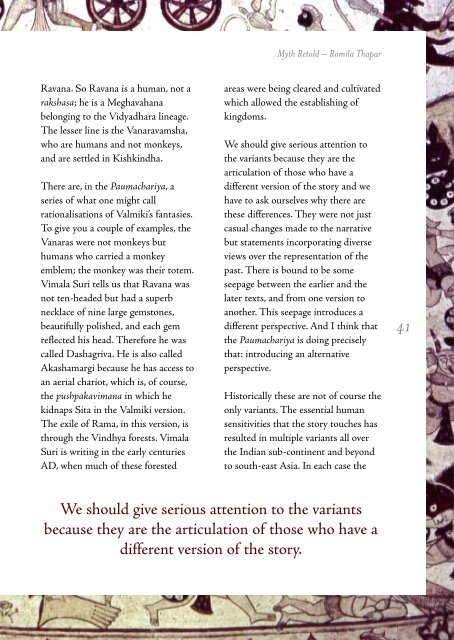Layout 3 - India Foundation for the Arts - IFA
Layout 3 - India Foundation for the Arts - IFA
Layout 3 - India Foundation for the Arts - IFA
You also want an ePaper? Increase the reach of your titles
YUMPU automatically turns print PDFs into web optimized ePapers that Google loves.
Ravana. So Ravana is a human, not a<br />
rakshasa; he is a Meghavahana<br />
belonging to <strong>the</strong> Vidyadhara lineage.<br />
The lesser line is <strong>the</strong> Vanaravamsha,<br />
who are humans and not monkeys,<br />
and are settled in Kishkindha.<br />
There are, in <strong>the</strong> Paumachariya, a<br />
series of what one might call<br />
rationalisations of Valmiki’s fantasies.<br />
To give you a couple of examples, <strong>the</strong><br />
Vanaras were not monkeys but<br />
humans who carried a monkey<br />
emblem; <strong>the</strong> monkey was <strong>the</strong>ir totem.<br />
Vimala Suri tells us that Ravana was<br />
not ten-headed but had a superb<br />
necklace of nine large gemstones,<br />
beautifully polished, and each gem<br />
reflected his head. There<strong>for</strong>e he was<br />
called Dashagriva. He is also called<br />
Akashamargi because he has access to<br />
an aerial chariot, which is, of course,<br />
<strong>the</strong> pushpakavimana in which he<br />
kidnaps Sita in <strong>the</strong> Valmiki version.<br />
The exile of Rama, in this version, is<br />
through <strong>the</strong> Vindhya <strong>for</strong>ests. Vimala<br />
Suri is writing in <strong>the</strong> early centuries<br />
AD, when much of <strong>the</strong>se <strong>for</strong>ested<br />
Myth Retold – Romila Thapar<br />
areas were being cleared and cultivated<br />
which allowed <strong>the</strong> establishing of<br />
kingdoms.<br />
We should give serious attention to<br />
<strong>the</strong> variants because <strong>the</strong>y are <strong>the</strong><br />
articulation of those who have a<br />
different version of <strong>the</strong> story and we<br />
have to ask ourselves why <strong>the</strong>re are<br />
<strong>the</strong>se differences. They were not just<br />
casual changes made to <strong>the</strong> narrative<br />
but statements incorporating diverse<br />
views over <strong>the</strong> representation of <strong>the</strong><br />
past. There is bound to be some<br />
seepage between <strong>the</strong> earlier and <strong>the</strong><br />
later texts, and from one version to<br />
ano<strong>the</strong>r. This seepage introduces a<br />
different perspective. And I think that<br />
<strong>the</strong> Paumachariya is doing precisely<br />
that: introducing an alternative<br />
perspective.<br />
Historically <strong>the</strong>se are not of course <strong>the</strong><br />
only variants. The essential human<br />
sensitivities that <strong>the</strong> story touches has<br />
resulted in multiple variants all over<br />
<strong>the</strong> <strong>India</strong>n sub-continent and beyond<br />
to south-east Asia. In each case <strong>the</strong><br />
We should give serious attention to <strong>the</strong> variants<br />
because <strong>the</strong>y are <strong>the</strong> articulation of those who have a<br />
different version of <strong>the</strong> story.<br />
41


